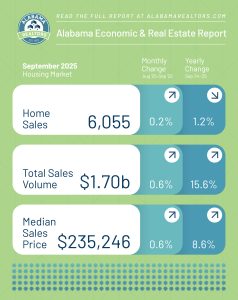MONTGOMERY – Home sales across Alabama remained steady in September and avoided the start of the traditional seasonal decline, according to the Alabama Economic and Real Estate Report released today by the Alabama Association of Realtors.
In the report, economists attributed the steady sales report to recent reductions in mortgage rates.
 “Inflation expectations increased, and consumer sentiment declined in September, but the state’s labor market remains relatively strong, and lower average mortgage rates aided with home sales,” Alabama Realtors economist Evan Moore said. “The Fed is likely to cut rates at its remaining meetings in 2025, which may bring tightening to an end and allow the housing market more room for growth.”
“Inflation expectations increased, and consumer sentiment declined in September, but the state’s labor market remains relatively strong, and lower average mortgage rates aided with home sales,” Alabama Realtors economist Evan Moore said. “The Fed is likely to cut rates at its remaining meetings in 2025, which may bring tightening to an end and allow the housing market more room for growth.”
The monthly report noted that Alabama experienced 6,055 homes sales in September, which represents a slight 0.2% increase over August and is just 71 fewer than one year ago, equating to a 1.2% annual decrease. When considering indicators, economists predict home sales will remain essentially steady over the next month, as well.
The median sales price grew by $18,625 year-over-year to $235,246, an 8.6% annual increase and a 0.6% monthly rise. The sold dollar volume in September, which is the combined sales price of all homes closed during the month, was $1.70 billion — just 0.6% higher than August, but the current combined yearly sales volume total is 15% more than 2024.
The number of listings basically leveled off with a 0.2% monthly decline, and homes remained on the market just one day longer in September compared to August.
The average 30-year fixed-rate mortgage fell to 6.26% through the first two and a half weeks of September, decreasing by 30 basis points from 6.56% at the end of August. Over the past 40 years, mortgage rates have averaged to 6.52%.
While the national unemployment rate rose to 4.3% in August, unemployment in Alabama fell to 2.9%, marking the third straight month of decline and the first time the statewide number has rested below 3% since June of 2024. The state’s labor force participation rate fell slightly from 58%, which was the highest level in a decade, to 57.7% and trails the national rate of 62.3%.
Though the ongoing government shutdown has affected the federal Bureau of Labor Statistics, the latest available numbers indicate that Alabama added roughly 3,800 jobs in July and August, which brings the total number of jobs in the state to 2,214,900.
Alabama’s real GDP increased by 1.2% during the second quarter of 2025, which was the fifth lowest state growth rate in the country and lagged the national GDP increase of 3.8%. Similarly, Alabama had the nation’s fifth lowest growth rate in personal income.
The second quarter numbers indicate a reversal of the previous quarter in which Alabama notched the third highest GDP growth rate and eighth highest income growth in the nation.
Don’t miss out! Subscribe to our email newsletter to have all our smart stories delivered to your inbox.



